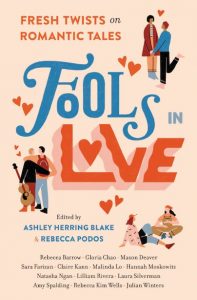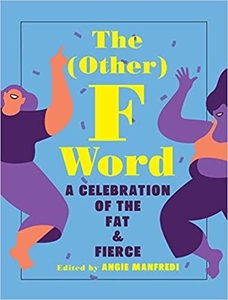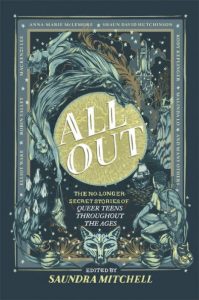Amazon Affiliate Link | Bookshop.org Affiliate Link
What I love about this collection is that nowhere on it does it say it’s a specifically LGBTQ anthology, but if you read sapphic YA, you’ll recognize those two editors and know you’re in for a treat. This is a collection of stories from fantastic YA authors (Rebecca Barrow, Ashley Herring Blake, Gloria Chao, Mason Deaver, Sara Farizan, Claire Kann, Malinda Lo, Hannah Moskowitz, Natasha Ngan, Rebecca Podos, Lilliam Rivera, Laura Silverman, Amy Spalding, Rebecca Kim Wells, and Julian Winters), each inspired by a romance trope, like Enemies to Lovers or Snowed In Together (a personal favourite).
While these are all love stories of some kind, they cover a range of genres, including fantasy and superhero stories. The first one, “Silver and Gold” by Natasha Ngan, may be my favourite. It’s a second chance F/F romance set during a fantasy dog-sledding competition. Well, wolf-sledding. Across treacherous terrain, and interrupted by a sea monster. And then she gets snowed in together with the competition. Who can resist that?
The first few stories were F/F, which I, obviously, loved. It turns out that there are very few M/F romances in this collection. Most of them are F/F, a couple are M/M, and a couple are M/F. It delights me that this isn’t being marketed as just LGBTQ, because we all know romance anthologies that include no queer people at all, or only one story, so this is a nice reversal. There also wasn’t, if I remember correctly, any homophobia faced in these stories.
As with all anthologies, the range of stories means there are some you’ll enjoy more than others, but overall I really liked this collection. Romance short stories can be tricky for me, because there’s so little space to get to know the characters, but most of these pulled that off and offered satisfying glimpses into these relationships.
Most of the stories play with a few different tropes, despite being assigned to one. There’s a M/M superhero/villain fake dating forbidden romance that’s also childhood friends to lovers, for instance.
Some of the other premises of the stories:
- a F/F romance where the main character is too awkward to explain to her crush that she is not, in fact, her rideshare driver, so she just drives her to her location. Relatable.
- a polyamorous M/M/F triad relationship that melted my heart
- a summer camp where the fat femme main character cosplays as a fairy and falls for another fairy–and also she’s cursed to only tell the truth
- a cute M/F fake dating at Passover story
- a girl goes back in time to kill the man who murdered her mother. Instead, she meets the murderer’s daughter and falls in love, before being yanked back to her time
- a trans M/M boy band romance
- a F/F scifi princess in disguise romance
- It’s (probably) the end of the world, with a comet on its way to Earth. What else do you do but break into the zoo with your ex girlfriend to pet the giraffes?
This has all the fuzzy feelings I expect from romance stories, but with a sprinkling of drama and even some action. The variety in genres kept it feeling exciting, and I really liked the tropes format–in fact, I would definitely read anthologies based on just one of many of these tropes (did I mention I am obsessed with the Snowed In Together trope?) If you want a cozy romantic read this December, this is a perfect choice.



